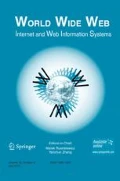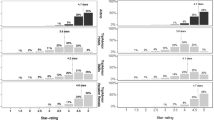Abstract
Social recommender systems largely rely on user-contributed data to infer users’ preference. While this feature has enabled many interesting applications in social networking services, it also introduces unreliability to recommenders as users are allowed to insert data freely. Although detecting malicious attacks from social spammers has been studied for years, little work was done for detecting Noisy but Non-Malicious Users (NNMUs), which refers to those genuine users who may provide some untruthful data due to their imperfect behaviors. Unlike colluded malicious attacks that can be detected by finding similarly-behaved user profiles, NNMUs are more difficult to identify since their profiles are neither similar nor correlated from one another. In this article, we study how to detect NNMUs in social recommender systems. Based on the assumption that the ratings provided by a same user on closely correlated items should have similar scores, we propose an effective method for NNMU detection by capturing and accumulating user’s “self-contradictions”, i.e., the cases that a user provides very different rating scores on closely correlated items. We show that self-contradiction capturing can be formulated as a constrained quadratic optimization problem w.r.t. a set of slack variables, which can be further used to quantify the underlying noise in each test user profile. We adopt three real-world data sets to empirically test the proposed method. The experimental results show that our method (i) is effective in real-world NNMU detection scenarios, (ii) can significantly outperform other noisy-user detection methods, and (iii) can improve recommendation performance for other users after removing detected NNMUs from the recommender system.
Similar content being viewed by others
References
Amatriain, X., Pujol, J.M., Oliver, N.: I like it... I like it not: evaluating user ratings noise in recommender systems. In: Proc. of the First Int’l Conf. on User Modeling, Adaptation, and Personalization (UMAP), pp. 247–258 (2009)
Benevenuto, F., Rodrigues, T., Almeida, V., Almeida, J., Gonçalves, M.: Detecting spammers and content promoters in online video social networks. In: Proc. of the 32nd Int’l ACM Conf. on Research and Development in Information Retrieval (SIGIR), pp. 620–627 (2009)
Brown, G., Howe, T., Ihbe, M., Prakash, A., Borders, K.: Social networks and context-aware spam. In: Proc. of the ACM Conf. on Computer Supported Cooperative Work (CSCW), pp. 403–412 (2008)
Burke, R., Mobasher, B., Williams, C., Bhaumik, R.: Classification features for attack detection in collaborative recommender systems. In: Proc. of the 12th ACM Int’l Conf. on Knowledge Discovery and Data Mining (KDD), pp. 542–547 (2006)
Chirita, P.A., Nejdl, W., Zamfir, C.: Preventing shilling attacks in online recommender systems. In: Proc. of the 7th ACM Int’l Workshop on Web Information and Data Management (WIDM), pp. 67–74 (2005)
Doyle, P.G., Snell, J.L.: Random Walks and Electric Networks. Mathematical Association of America (1984)
Guy, I., Carmel, D.: Social recommender systems. In: Proc. of the 20th Int’l Conf. on World Wide Web (WWW), pp. 283–284 (2011)
Hurley, N.: Robustness of recommender systems. In: Proc. of the Fifth ACM Conf. on Recommender Systems (RecSys), pp. 9–10 (2011)
Hurley, N., Cheng, Z., Zhang, M.: Statistical attack detection. In: Proc. of the Third ACM Conf. on Recommender Systems (RecSys), pp. 149–156 (2009)
Jagatic, T.N., Johnson, N.A., Jakobsson, M., Menczer, F.: Social phishing. Commun. ACM 50(10), 94–100 (2007)
Jindal, N., Liu, B.: Review spam detection. In: Proc. of the 16th Int’l Conf. on World Wide Web (WWW), pp. 1189–1190 (2007)
Koutrika, G., Effendi, F.A., Gyöngyi, Z., Heymann, P., Garcia-Molina, H.: Combating spam in tagging systems. In: Proc. of the 3rd Int’l Workshop on Adversarial Information Retrieval on the Web (AIRWeb), pp. 57–64 (2007)
Lam, S.K., Riedl, J.: Shilling recommender systems for fun and profit. In: Proc. of the 13th Int’l Conf. on World Wide Web (WWW), pp. 393–402 (2004)
Lee, K., Caverlee, J., Webb, S.: Uncovering social spammers: social honeypots + machine learning. In: Proc. of the 33rd Int’l ACM Conf. on Research and Development in Information Retrieval (SIGIR), pp. 435–442 (2010)
Li, B.: Cross-domain collaborative filtering: a brief survey. In: Proc. of the 23rd IEEE Int’l Conf. on Tools with Artificial Intelligence (ICTAI), pp. 1085–1086 (2011)
Li, B., Yang, Q., Xue, X.: Can movies and books collaborate? Cross-domain collaborative filtering for sparsity reduction. In: Proc. of the 21st Int’l Joint Conf. on Artificial Intelligence (IJCAI), pp. 2052–2057 (2009)
Lim, E.P., Nguyen, V.A., Jindal, N., Liu, B., Lauw, H.W.: Detecting product review spammers using rating behaviors. In: Proc. of the 19th ACM Int’l Conf. on Information and Knowledge Management (CIKM), pp. 939–948 (2010)
Malik, Z., Bouguettaya, A.: Rater credibility assessment in web services interactions. World Wide Web 12(1), 3–25 (2009)
Mehta, B.: Unsupervised shilling detection for collaborative filtering. In: Proc. of the 22nd National Conf. on Artificial Intelligence (AAAI), pp. 1402–1407 (2007)
Mehta, B., Hofmann, T., Fankhauser, P.: Lies and propaganda: detecting spam users in collaborative filtering. In: Proc. of the 12th Int’l Conf. on Intelligent User Interfaces (IUI), pp. 14–21 (2007)
Mehta, B., Nejdl, W.: Unsupervised strategies for shilling detection and robust collaborative filtering. User Model. User-Adapt. Interact. 19(1–2), 65–97 (2009)
O’Mahony, M., Hurley, N., Kushmerick, N., Silvestre, G.: Collaborative recommendation: a robustness analysis. ACM Trans. on Internet Tech. 4(4), 344–377 (2004)
O’Mahony, M.P., Hurley, N.J., Silvestre, G.C.M.: Recommender systems: attack types and strategies. In: Proc. of the 20th National Conf. on Artificial Intelligence (AAAI), pp. 334–339 (2005)
O’Mahony, M.P., Hurley, N.J., Silvestre, G.C.M.: Detecting noise in recommender system databases. In: Proc. of the 11th Int’l Conf. on Intelligent User Interfaces (IUI), pp. 109–115 (2006)
Resnick, P., Iacovou, N., Suchak, M., Bergstrom, P., Riedl, J.: Grouplens: an open architecture for collaborative filtering of netnews. In: Proc. of the ACM Conf. on Computer Supported Cooperative Work (CSCW), pp. 175–186 (1994)
Sarwar, B., Karypis, G., Konstan, J., Riedl, J.: Item-based collaborative filtering recommendation algorithms. In: Proc. of the 10th Int’l Conf. on World Wide Web (WWW), pp. 285–295 (2001)
Williams, C.A., Mobasher, B., Burke, R.: Defending recommender systems: detection of profile injection attacks. Service Oriented Comp. and Appl. 1(3), 157–170 (2007)
Yang, J., Fung, G.P.C., Lu, W., Zhou, X., Chen, H., Du, X.: Finding superior skyline points for multidimensional recommendation applications. World Wide Web 15(1), 33–60 (2012)
Zhu, X.: Semi-supervised learning literature survey. Tech. Rep. 1530, Computer Sciences, University of Wisconsin-Madison (2005)
Author information
Authors and Affiliations
Corresponding author
Rights and permissions
About this article
Cite this article
Li, B., Chen, L., Zhu, X. et al. Noisy but non-malicious user detection in social recommender systems. World Wide Web 16, 677–699 (2013). https://doi.org/10.1007/s11280-012-0161-9
Received:
Revised:
Accepted:
Published:
Issue Date:
DOI: https://doi.org/10.1007/s11280-012-0161-9




